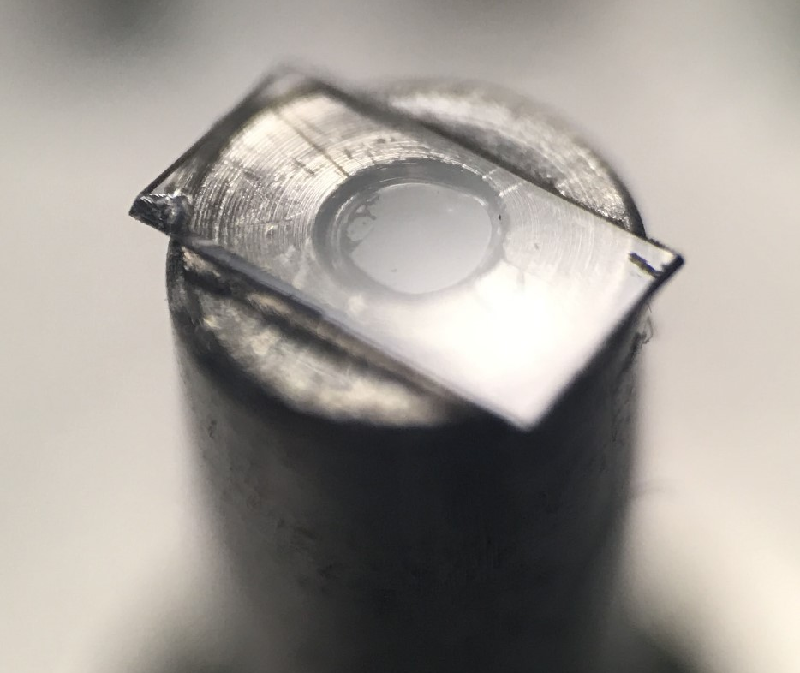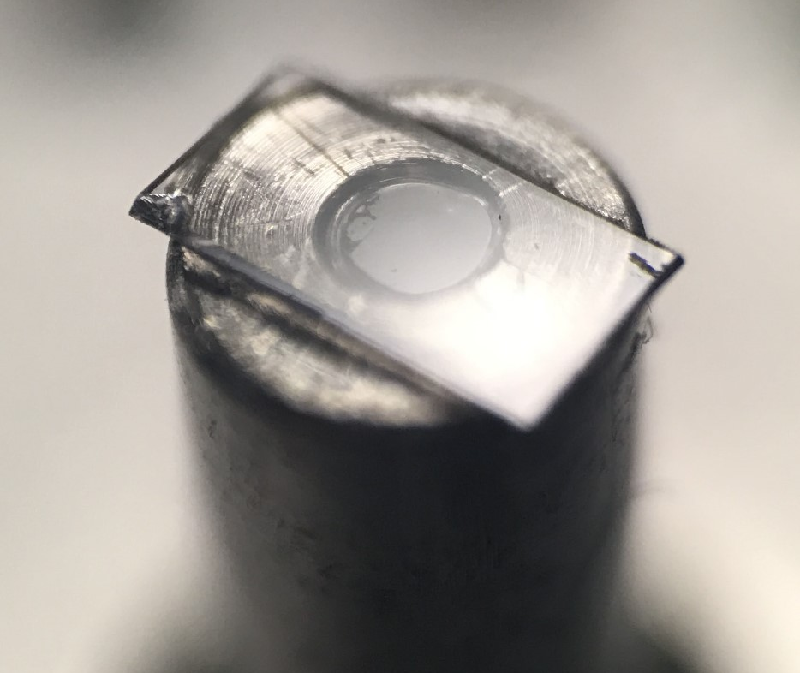Detecting the Rotation of a Quantum Spin
A new experiment has demonstrated that rotating a quantum object affects its spin in a way that can be detected. Researchers whirled a crystal at 200,000 rpm and detected the effects on a single quantum spin within the crystal. The finding was theoretically expected, but it could lead to new techniques for sensing rotation at the nanometer scale.
Particles such as electrons and protons have fixed values of quantum spin, an intrinsic angular momentum that does not correspond to physical rotation of the particle as it does for classical objects. Place such a particle (a single “spin”) in a magnetic field, and its spin vector rotates, or precesses, around the direction of the field vector, rather like a gyroscope. The speed of precession depends on the magnetic-field strength. Many influences, such as the fields of neighboring atoms, can affect the field that the spin experiences and thus the precession speed. If the particle has spin 1/2, then in an upward-pointing magnetic field it has a lower-energy (spin-up) state and a higher-energy (spin-down) state. Electromagnetic radiation with the same frequency as the precession can excite transitions between these two states.
It has been known for some time that the physical rotation of quantum spins (say, as part of a crystal) can alter the rate at which they precess, and some researchers hope that this fact might lead to a device for ultrasensitive detection of rotation [1]. Previous experiments have shown the effect for a large collection of spins, but doing so with a single spin would provide the ultimate in miniaturization and high spatial resolution. “How do you get a single spin to tell you that it’s rotating?” asks Alexander Wood of the University of Melbourne in Australia. The challenge, he says, is to show unambiguously that it is the rotation, and not some other influence such as a stray magnetic field, that has produced the effect on precession. The team overcame this difficulty by developing a complicated experiment that shows the effect of rotation indirectly.
Wood and his colleagues looked at diamond-crystal defects called nitrogen vacancy centers (NVs): places in the lattice where a lone nitrogen atom has replaced a carbon atom immediately adjacent to a vacancy (missing atom). This replacement leaves an unpaired electron, and it interacts with other electrons to create what is effectively—in the appropriate magnetic fields—an isolated spin-1/2 particle. If the NVs are very sparse, each spin can be seen and studied individually.
The team attached a small slab of diamond containing NVs to a motor spinning at 200,000 rpm in an external magnetic field. They looked at one NV and applied a technique called optically detected spin-echo magnetic resonance. For each rotation cycle (lasting a fraction of a millisecond), the team placed the spin in a lower-energy state using a green light pulse and then hit the spin with three carefully-timed microwave pulses. Finally, at the end of each rotation cycle, they measured the fluorescence emitted, which signaled whether the spin had been excited to the higher-energy state.
The orientations of the microwaves’ field vectors (polarizations) with respect to the spin determined the probability of the spin being excited to the higher-energy level. Using a theory accounting for this effect, the precession of the spin in the applied and microwave fields, and other effects, the team predicted the change in fluorescence as they varied the microwave polarization angle. These predictions agreed with the experiments. It turned out that the effect of varying the microwave orientation provided a signature in the fluorescence that uniquely signaled the NV’s rotation and could not be explained by other factors.
The current experiment is a proof-of-principle with limited sensitivity, Wood says, but in the future, similar measurements could be used to detect rotation with high precision. The low sensitivity results from the tiny sensor volume, essentially a single atom. But he says that this probe size could also be an advantage: a nanometer-sized diamond containing a single NV might act as a probe for sensing rotation of living cells or biological fluids.
Pauli Kehayias of Sandia National Laboratory in Albuquerque, New Mexico, says that some researchers are already trying to use diamond NVs as the basis for a gyroscope that detects slow rotation [2–4], for example in navigation. But he says that using individual spins could lead to fast-rotation sensors that work at the atomic scale. In addition, a single spin would avoid complications from the inhomogeneity that might exist in a group of many NVs.
This research is published in Physical Review Letters.
–Philip Ball
Philip Ball is a freelance science writer in London. His latest book is How Life Works (Picador, 2024).
References
- E. A. Donley, “Nuclear magnetic resonance gyroscopes,” IEEE Xplore Conference: Sensors 2010, 17 (2010).
- D. Maclaurin et al., “Measurable quantum geometric phase from a rotating single spin,” Phys. Rev. Lett. 108 (2012).
- M. P. Ledbetter et al., “Gyroscopes based on nitrogen-vacancy centers in diamond,” Phys. Rev. A 86, 052116 (2012).
- A. Ajoy and P. Cappellaro, “Stable three-axis nuclear-spin gyroscope in diamond,” Phys. Rev. A 86, 062104 (2012).





